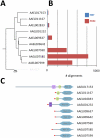The fat body transcriptomes of the yellow fever mosquito Aedes aegypti, pre- and post- blood meal
- PMID: 21818341
- PMCID: PMC3144915
- DOI: 10.1371/journal.pone.0022573
The fat body transcriptomes of the yellow fever mosquito Aedes aegypti, pre- and post- blood meal
Abstract
Background: The fat body is the main organ of intermediary metabolism in insects and the principal source of hemolymph proteins. As part of our ongoing efforts to understand mosquito fat body physiology and to identify novel targets for insect control, we have conducted a transcriptome analysis of the fat body of Aedes aegypti before and in response to blood feeding.
Results: We created two fat body non-normalized EST libraries, one from mosquito fat bodies non-blood fed (NBF) and another from mosquitoes 24 hrs post-blood meal (PBM). 454 pyrosequencing of the non-normalized libraries resulted in 204,578 useable reads from the NBF sample and 323,474 useable reads from the PBM sample. Alignment of reads to the existing reference Ae. aegypti transcript libraries for analysis of differential expression between NBF and PBM samples revealed 116,912 and 115,051 matches, respectively. De novo assembly of the reads from the NBF sample resulted in 15,456 contigs, and assembly of the reads from the PBM sample resulted in 15,010 contigs. Collectively, 123 novel transcripts were identified within these contigs. Prominently expressed transcripts in the NBF fat body library were represented by transcripts encoding ribosomal proteins. Thirty-five point four percent of all reads in the PBM library were represented by transcripts that encode yolk proteins. The most highly expressed were transcripts encoding members of the cathepsin b, vitellogenin, vitellogenic carboxypeptidase, and vitelline membrane protein families.
Conclusion: The two fat body transcriptomes were considerably different from each other in terms of transcript expression in terms of abundances of transcripts and genes expressed. They reflect the physiological shift of the pre-feeding fat body from a resting state to vitellogenic gene expression after feeding.
Conflict of interest statement
Figures



References
-
- Wattam AR, Christensen BM. Further evidence that the genes controlling susceptibility of Aedes aegypti to filarial parasites function independently. J Parasitol. 1992;78:1092–1095. - PubMed
-
- September 2010. Dengue Fever Fact Sheet http://www.cdc.gov/ncidod/dvbid/dengue.
-
- Chapman RF. The Insects, Structure and Function. New York: Cambridge University Press; 1998.
-
- Chandrasekar R, Jae SS, Krishnan M. Expression and localization of storage protein 1 (SP1) in differentiated fat body tissues of red hairy caterpillar, Amsacta albistriga Walker. Arch Insect Biochem Physiol. 2008;69:70–84. - PubMed
Publication types
MeSH terms
Substances
Grants and funding
LinkOut - more resources
Full Text Sources
Research Materials

